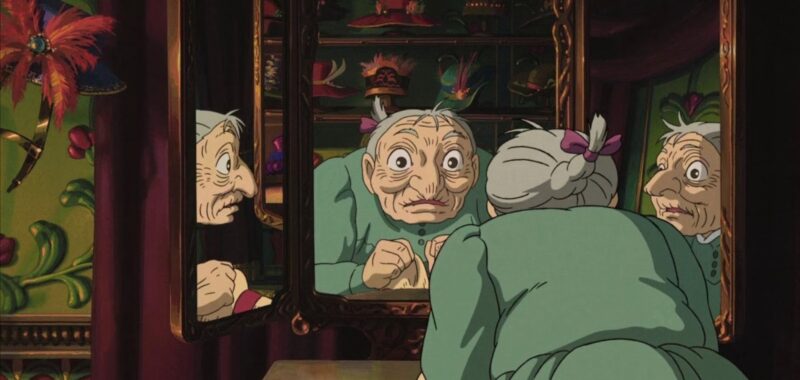Back in 1986 my grandmother—the late, great Diana Wynne Jones—wrote a book called Howl’s Moving Castle. Years later, it was adapted by Hayao Miyazaki into an Oscar-nominated film of the same name. I remember excitedly attending the first UK screening in 2005, and have watched it countless times since. From the memorable characters to the sublime Joe Hisaishi soundtrack, it’s a Studio Ghibli classic.
The animated feature is a departure from the book in lots of ways. There are absences: none of it takes place in Wales, “seven-league boots” don’t feature, and neither does the book’s primary antagonist. There are additions too, from a dog that wheezes like an accordion to monstrous airships and corrupted wizards. It’s set against the dark backdrop of war, as many of Miyazaki’s films are. In this instance, it was influenced by his opposition to the invasion of Iraq.

All those differences were the result of Miyazaki’s singular creative vision—one which my grandmother loved. She shared a mutual admiration with Miyazaki for many years; her in Bristol, him in Tokyo. It wasn’t until he made the film that they talked in person with the help of a translator. In an interview from around that time, she described how “he understood my books in a way nobody else has ever done”.
Crucially, the differences between the source material and the film are what makes it distinctly Ghibli. Howl’s Moving Castle wasn’t so much adapted as it was transmuted. In both versions, characters can twist a dial above the door of the titular castle to be transported to different places. What happened to the book was more than a twist of that dial. It shifted dimension, with ideas, characters, and plot all pulling apart and recombining into something that’s different on a molecular level.

The animation itself is a painstaking process too. Not only must ideas gestate and be written up into a compelling script, but that script needs to be storyboarded and visualised. From there, a team of animators hand-draws individual frames. Producer Toshio Suzuk reported that it took a month to produce a minute of “The Boy and the Heron”. These films are the product of years of careful work.
Invasion of the Ghibli Twinks
Fast forward to the present day and social media is plastered with Ghibli-styled images, produced using ChatGPT’s new image generation feature. Hayao and Goro Miyazaki’s masterful filmography has been reduced to just another prompt in the endless churn of AI imagery. GPT-4o takes an existing image and remixes it based on the Studio’s distinctive style. Users turn the castle’s dial and the image changes, whether it’s a photo or an iconic shot from a film.

Over the past week, I’ve seen everything from Donald Trump and JD Vance’s combative talks with Volodymyr Zelenskyy to Derek Chauvin’s murder of George Floyd have the GenAI Ghibli treatment. Some social media users seem to revel in the dissonance between twee visuals and horrific images, seemingly unaware that Studio Ghibli has a long history of representing atrocities and fascism in its films.
The viral phenomenon was led by OpenAI CEO Sam Altman himself, who changed his profile picture on X to a Ghibli portrait. Later, he shared an anime image generated on a live stream by 4o’s Image Gen Lead, Gabriel Goh. Disconcertingly, the animated version of Goh has four fingers. But that’s hardly breaking new ground for AI imagery.

It’s no coincidence that Studio Ghibli’s distinctive visual style has become the poster child for the ChatGPT update. In an X post, one user noted that “openai is incredibly fortunate the positive vibes of ghibli was the first viral use of their model and not some awful deepfake nonsense”. Altman responded: “we put a lot of thought into the initial examples we show when we introduce new technology”.
In other words, the Ghiblification of OpenAI’s image generation launch was likely a calculated move to ensure that people viewed the new feature in a good light. Many people have positive associations with Studio Ghibli’s work, drawing from deep wells of emotion and nostalgia. Plus, the anime style is forgiving, avoiding the uncanny valley that photorealistic GenAI images still fall into.
Another of Atman’s posts presented the viral phenomenon as spontaneous. Using a Reddit greentext format, he described waking up to discover “hundreds of messages” sharing images of him as a “twink ghibli style”. He founded OpenAI to cure cancer (or whatever), only for people to use his products to generate silly images! The elephant in the room, of course, is that he just launched an image generator and is actively promoting it.
At best, Ghibli-themed GenAI image creation is an amusing gimmick. You turn Sam Altman into a twink ghibli style haha. At worst, as many have pointed out, it’s an insult to one of the greatest living filmmakers—someone who is on record saying that the use of AI tools in artistic production “is an insult to life itself.”
Such practices could be illegal too. It’s hard to imagine GPT-4o is able to match Studio Ghibli’s distinctive visual style in its output without being trained on stills extracted from its films. If it was, OpenAI did so without the studio’s permission. What constitutes copyright infringement when training models is still an open question in much of the world, although Japan is notably leniant on fair use.
Above all, this latest fad reveals how shallow GenAI “art” often is. As “Howl’s Moving Castle” showed, taking something and turning it into a Studio Ghibli production is a drawn-out, idiosyncratic process. Things get lost along the way. But that’s a conscious process, unlike the loss of one of Goh’s fingers. Entirely new ideas spring up to take their place, often inflected by Miyazaki’s own sensibilities and responses to the world around him.
The film is an example of what happens when you actually make something Ghibli. The source material is changed, irrevocably, because of a creative process that’s uniquely human.

